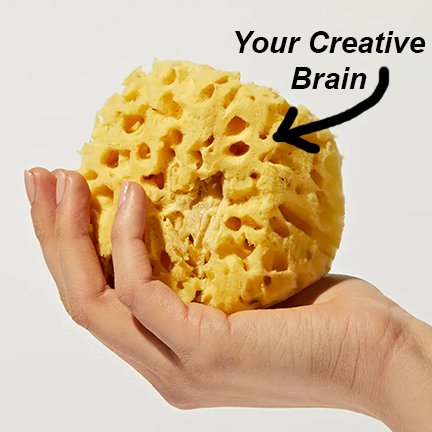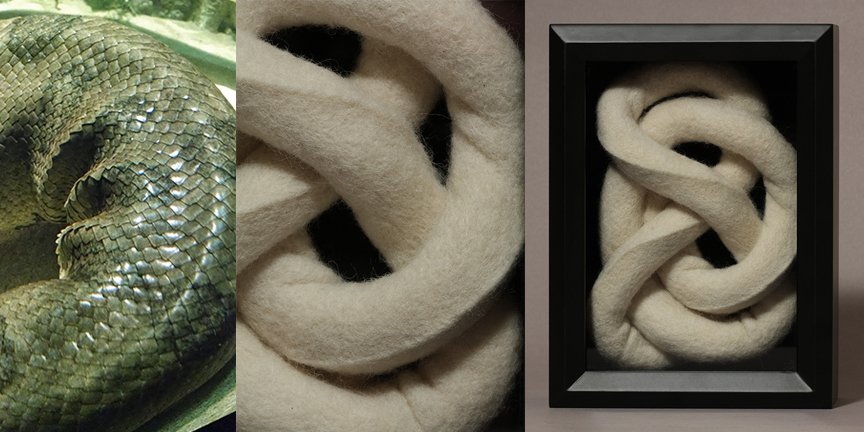Answering Questions About Creativity: Being a Sentient Sponge
“So…you make weird and mysterious things. How do you decide what to make? How do you come up with original ideas? Who and what inspires you?”
I believe one of the characteristics of creative people is the tendency to notice what they notice-- to take note of the things that stand out and draw their attention. That’s the first step- being curious and engaged. Responding by remembering or writing or sketching or recording or photographing interesting things--whether they’re mundane or exceptional--is the next step. What’s mundane to others may be exceptional to YOU, after all.
A small selection of plant life observed on dog walks, in my garden, or out in the world. Daily life provides forms to imitate, sometimes quite directly.
But creativity truly grows from the act of making connections between all those hoarded snippets of noticing and seeing how they might play out. Creativity is exploring what it would look like or sound like or feel like to recombine or substitute or capture or emphasize things, or simply to recreate something in a particular process or instrument or movement or material, depending on your discipline. For me, materials are a real entry point. Thick industrial felt, for example, is quite mundane and theoretically boring, yet it can be cut into patterns and stitched together to embody a sense of fullness, solidity, and weight— despite being lightweight.
A sketchbook page showing ideas for organic/geometric forms, paired with completed ‘Holdable’ sculptures made of stitched industrial felt, measuring approximately 3 feet wide each.
It’s like being a sentient sponge as you go through life-- soaking up interesting things without prejudging precisely what you’ll do with them.
So how do I decide what to make to squeeze out the results of the sponging?
I trust my excitement.
By now I have a huge library of ‘interesting things’ in my sketchbooks, in my phone’s camera roll, and in my head. If there’s something that sparks excitement, I trust that it’s something I should address through my materials.
I recently found this strange citrus fruit while walking my dog, and couldn’t stop looking at its wormy surface pattern. Trying to figure it out (and how light and shadow might communicate and define those structures) inspired one of my still-in-process Objects of Intrigue wool drawings.
Trust in oneself is key to coming up with original ideas. An original idea is by definition something different and new, and it can be intimidating to make something that veers from what already exists, much less show it to the judgment-filled wider world.
Creativity requires trust because otherwise every new idea would be dismissed before it could come to any fruition. Trust that one’s own curiosity or reaction is worthwhile, even if (or especially if) it’s weird, offbeat, different or unusual. Trust that one’s unique lens of life experiences and accumulated (or newly acquired) skills are enough to start with. Trust that the road is more important than the destination, that uncertain outcomes are the only real certainty. Trust that ‘failures’ are in fact learning experiences. Trust that one’s own satisfaction in exploration is what matters, regardless of outside reactions.
In my own studio practice I’ve spent a lot of years indulging in playful experimentation and learning to trust myself. Twenty-some years in, following my interests and trusting myself have become habits. I know that I respond again and again to certain types of forms found on human and animal bodies and echoed in plant life and even geological features: full, swelling roundness, folds of flesh, sharp, clean edges that morph into smooth planes. There’s some sense of a life force, a potential for movement, or maybe simply a satisfying way my eye travels over such forms that feels valuable and important to me.
The folds of flesh on a snake I photographed at the California Academy of Sciences informed the physical logic of this snaky form I created out of needle felted wool. For me there’s a satisfaction in making something that makes sense to the human observer (at least in its believable physical qualities) regardless of meaning assigned or suggested by the artwork.
But not every experiment results in something wonderful, of course. Artmaking is like a journey where some directions are rewarding and branch into new highways, roads, and paths; but unless they visit my studio, the audience doesn’t necessarily see the dead ends, the cul-de-sacs, and the parking lots (to take another metaphor way too far). Happily there is still plenty to learn from a ‘failed’ experiment.
I also stand on the shoulders of giants. Like so many other disciplines there are incredible people to learn from, both directly and by observation. There are approaches to mimic or reject, techniques to master or adapt, forms to admire and wish you’d made. Some of the artists who inspire me include Martin Puryear, Eva Hess, Georgia O’Keeffe, Louise Bourgeois, Ernesto Neto, and Lee Bontecou. I feel an affiliation with these artists because of the way they’ve manipulated inert materials to make them sing of different stages of life: fresh budding, maturation, and even decay.
Left to right, top row: Martin Puryear “Old Mole”; Louise Bourgeois “Cell XXVI (detail)”; Lee Bontecou, “Untitled 1962”. Left to right, bottom row: Ernesto Neto “The Malmö Experience”; Eva Hesse “Ringaround Arosie”; Georgia O’Keeffe “Shell”
So my weird and mysterious things-- sculpture and drawings-- are a combination and a distillation of the unique experiences and observations of my particular life. These are the squeezings of my sponge. Not everyone will appreciate what I make and some question if it’s even art, and that’s okay. I’m going to keep on soaking it all in anyway.






